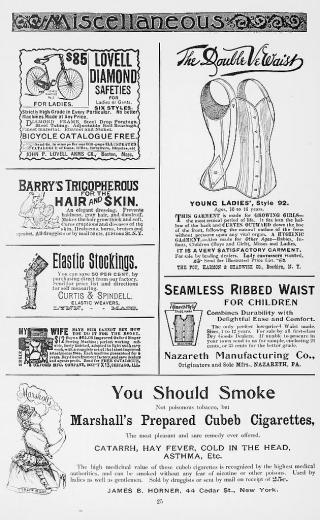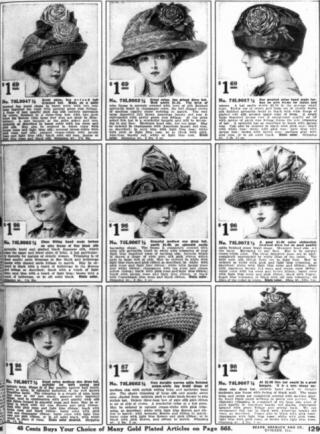Shop Til’ You Drop

Americans love to shop from video games and electronics to cosmetics and fashion shopping is truly an American pastime. Our culture defines shopping as a feminine pursuit. Commercials often feature overzealous female shoppers just itching to catch a bargain on the latest sale. Magazines, movies, and ads display the image of women up to their ears with shopping bags, fatigued by a long and arduous day of shopping. In our consumer culture women are seen as the primary consumers. But why and how did consumerism and shopping come to be associated with femininity?
Impact of the Industrial Revolution
Modern American consumer culture arose on the backdrop of the 19th century. During a time of rapid urbanization and industrialization there was a fundamental shift in cultural attitudes towards women. By the mid-1800s the Industrial Revolution was well underway, which included the manufacture of cotton and wool. Clothing was especially transformed. Past generations sewed every stitch of garments, even raising sheep to provide wool. Whereas, new textile and garment factories allowed low-cost purchases of ready-made clothing. According to Dr. Susan Strasser, “This period of time, when consumer culture was really coming to the fore in the United States was a time of tremendous change. A time of really seismic shifts in everything about American culture, American society, the American economy. How people spent their days, how people made their livings, how people got their clothes, how people got their furniture, how people got all of the material of daily life.”
With this new mass production of goods businesses crafted new methods of distribution, promotion, and sales. This established the framework of our modern consumer culture. As businesses thought of new ways to sell their products and expand consumer demand they adopted new methods of merchandising, packaging, and advertising. The image of the female consumer was a cultural and marketing phenomenon that emerged from new advertising. Consumer identity became linked with notions of femininity and was seen as the way to a better life.
Dr. Elaine Abelson found that, “The fashion industry itself promoted the idea of women as consumers. A quick look at any publication will give you a very clear sense of women in their many many social roles. These are mostly middle-class women: women in sports, from women buying soap, to women with children, to women with animals, to women in the early 20th century in Model T cars. It's an amazing use of women as models in any way that would sell merchandise.”
Fashion Magazines and Home Shopping

Advertisements from an 1893 Godey's Lady's Book for bicycles, corsets, cigarettes, elastic stockings, and other products.
Godey's Lady's Book set the precedent for women's magazines and by the turn of the century the big six women's magazines, Ladies Home Journal, McCall’s Magazine, The Delineator, Pictorial Review, and Good Housekeeping, had been founded. “All of the big women's magazines of the 20th century did appear during this time: Ladies Home Journal, Woman's Home Companion, Vogue, McCall's. Some of them started as the kind of wish books that went along with the pattern companies that sold patterns for dresses. Some of them had been farm journals. But they turned into a new kind of magazine. The women's magazine which both offered articles that appealed to women who were doing this new task of consumption and they offered advertisers a place to find those women.” said Dr. Strasser.
Fashion magazines were not only an avenue for advertisers, but also an employment opportunity for women. Maud Humphrey Bogart did illustrations for Harper's and Century magazines and later was the art director for the fashion magazine The Delineator. Jessie Willcox Smith earned an estimated annual income of $12,000 in 1910. She received between $1,500 and $1,800 for each of the nearly 200 Good Housekeeping covers she illustrated between 1917 and 1933.

Page from Sears, Roebuck & Co catalog from 1899
For women who lived outside of large cities mail-order houses like Sears and Montgomery Ward, which were also established during this time, made it possible to bring the conveniences of the city to rural areas. Women made purchases from the company's mail-order catalogs and their goods were mailed to them. The first year's catalog was published in 1888 and featured watches and jewelry. By 1894, the catalog had expanded to include sewing machines, sporting goods, and clothing.
Breaking in to the Fashion Industry
By the early 20th century women were gaining access to higher education, professional careers, and jobs including careers in fashion. One of these creative and industrious women in fashion was designer Elizabeth Hawes. She was an outspoken critic of her industry and encouraged women to wear what they wanted instead of merely accepting the latest fashion. Hawes was also a union organizer, political activist, and a proponent of gender equality. In 1925 she started her first job in Paris where she was employed to steal designs from leading couturiers. She was disillusioned with her work and left the copy house in 1926 to become a sketcher in New York. During the Great Depression Hawes asked her women employees, who were often supporting unemployed families, what they needed to survive and paid them accordingly.
World War II and the 1940s brought new challenges as both clothing and shoes were rationed. Since millions of men went into the military some women were able to reach executive positions. Lord & Taylor's Dorothy Shaver was one of them. She was initially hired in the 1920s to work for the company's comparison bureau, the main function of which was to spy on other stores. Shaver was elected Lord & Taylor's first female president in 1945. The company was the first major store on Fifth Avenue to appoint a woman to the top position. Muriel King dressed some of Hollywood's most iconic stars such as Katharine Hepburn and Ginger Rogers. No Hollywood designer though was as important as Edith Head. She was hired to sketch fashion designs in the 1920s for Paramount Studios and ran the entire design department 15 years later. She later worked for both Paramount and Universal studios and designed for an impressive 987 Hollywood films. Her designs included beautiful head beaded dresses for Carole Lombard who starred in 1930s and 40s films. Head eventually won eight Oscars for her work.

During the 1940s another designer, Claire McCardell, became known for creating the American look. She was a talented fashion designer and provided American women with well-made and smart looking casual ready-to-wear clothes. From the 1930s to 1950s she was known for designing functional affordable and stylish clothing. Her American look played on wartime patriotism and her 1942 popover dress was an inexpensive, attractive, denim wraparound dress that women could easily move in.
During the industrial revolution the mass production of affordable goods and marketing campaigns target women. Together they created a consumer culture that still exists today with women at the center.
